Trinity Hall, home of the Seven Incorporated Trades of Aberdeen, will welcome the public this Saturday [October 1] as part of the deferred Doors Open programme.
Many of the ancient society’s relics will be on display, including a collection of extremely rare chairs, some dating back almost five centuries.
The collection of 28 chairs is regarded as the most complete of its kind in not only Scotland, but Europe, and each has a story to tell.
The seven trades, hammermen, bakers, wrights and coopers, tailors, shoemakers, weavers and flesher have been incorporated now for 435 years.
They came together originally in the belief that unity would give them a voice in the development of Aberdeen commerce and protect their interests and privileges against encroachment by the merchant class of burgesses, with whom they were in constant conflict and dispute.
Upholding tradition
Nowadays the society upholds many of its ancient traditions, including the care and wellbeing of its members with pensions and support for widows; fund-raising to help with the education of young people in the Aberdeen area; and looking after the historical artefacts of the seven trade crafts of the city—including the 28 remarkable chairs.
Some hark back to the time when craftsmen held their meetings in Deacons’ houses, and bear dates as far back as 1574.
They are often heavily carved, adorned either with the symbols of the trades to which they belong, or the armorial bearings of the Deacons or craftsmen, complete with their initials.
Look but don’t sit!
They’ve been restored and repaired over the passage of time and it was eventually decided to withdraw them from use for their own protection.
At that point two new ceremonial chairs were commissioned in 2009, in a contemporary style, to be used by the Deacon Convener and Master of Trades Hospital at ceremonial occasions and functions in Trinity Hall.
They were designed by ex-Deacon Convener George Ross and built by one of the members.
David Parkinson is an ex-Deacon Convener of the Seven Incorporated Trades of Aberdeen.
He said: “You’ll be able to see the whole collection on display on Saturday.
“It’s one of the most significant chair collections in Europe and exceptionally rare to have it in one place.
“They all have specific features unique to their time. One even converts into a table by tipping back.
“But no sitting, no touching—the chairs aren’t exactly fragile, but they need respect for their age.”
The society boasts the top craft workers in the north-east, so perfectly placed to carry out maintenance on the chairs during their annual checks.
The Hookmakers’ chair and portrait
One chair, dating back to 1690, was presented along with a portrait of its donor, hookmaker Patrick Whyt.
Whyt was several times Deacon of the Hammermen Trade, with which the hookmakers were associated.
The upper part of the back panel is carved with three interlocking or crossed fishing hooks between the castle, anvil, Royal crown and hammer from the Hammermen’s arms, held in an upright position by a hand.
The initials ‘P W’ are detailed on the lower right corner of the panel, and carved out in the lower section is the inscription in italics ‘Patrik Whyt, hookmaker, Deacon conr., 1690’.
Whyt wielded considerable importance around Aberdeen, and was elected Deacon Convenor no less than seven times between 1690 and 1705.
The Weavers’ chair of 1684
No one knows who donated this impressive piece.
David said: “The back of this chair includes the Weavers’ coat of arms with a carved inscription `Weavers’ and the words ‘Spero In Deo Et Ipse Facit’, which means ‘Hope in God and do it yourself’.
The chair itself is quite plain but has a feature rarely found in British chairs.
“All four of the stretchers [horizontal supports] are shaped on their lower sides, the seat rail is undercut on and the stretchers are also shaped underneath,” David said.
The mahogany Fleshers’ chair
This was donated in 1661 by Andrew Watson.
He was Deacon of the Fleshers when they joined the other trades to make up the Seven Incorporated Trades of Aberdeen.
Very exotically for the time, it is the only chair in the collection to be carved from mahogany and said to be one of the oldest mahogany chairs in the world, let alone Britain.
It includes the Watson coat of arms and a shield with the tools of the flesher trade highlighted in red and gold pain on the upper part of the back.
David said: “A possible explanation for this very early use of mahogany might be owing to Aberdeen’s importance as a trading port.
“It’s quite possible that more exotic woods were occasionally brought in.”
The Weavers’ upholstered chair
This chair is unlike any of the others in the collection, in its design and also because it’s on wheels.
David said: “It is also one of few chairs which is upholstered and it belongs to the Old Aberdeen Weavers.
“The jar of lilies found on the shield signifies this, as it is the symbol on the Old Aberdeen coat of arms.
“The chair also has lion heads carved into the arms of the chair and there are mermaids flanking the shield with the weavers’ arms.”
A walk back through five centuries
As if the chairs weren’t enough, there’s a lot more on display for visitors to marvel at in Trinity Hall.
David said: “It’s like a history of the city of Aberdeen from 1500.
“There are 98 portraits of those who’ve gone before, and many objects made as essay pieces by aspiring members to show themselves suitable for membership.
“These include doors, windows shoes, weaving, lots of timber work and a collection of antique swords.”
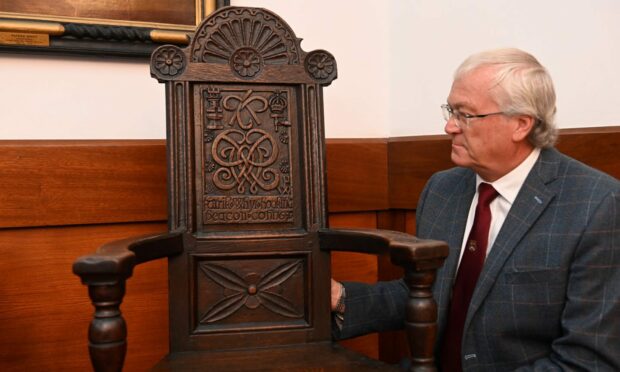

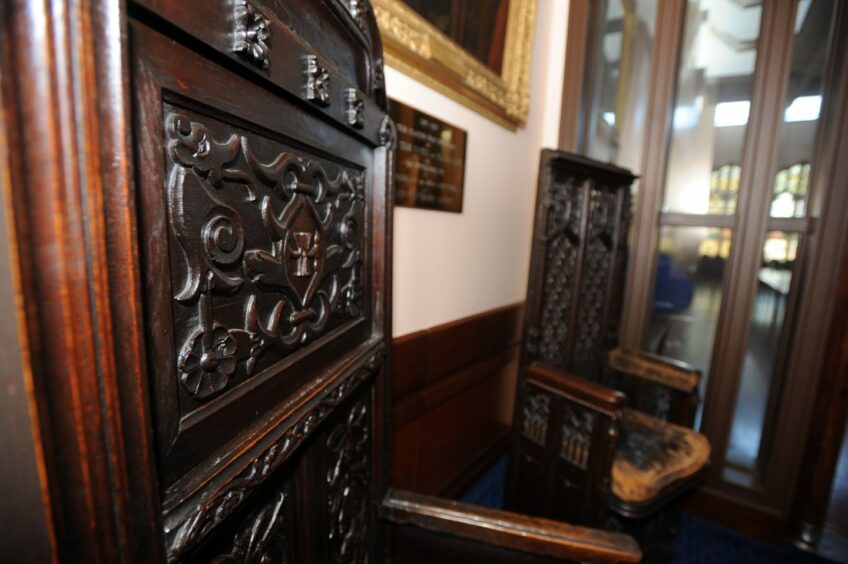
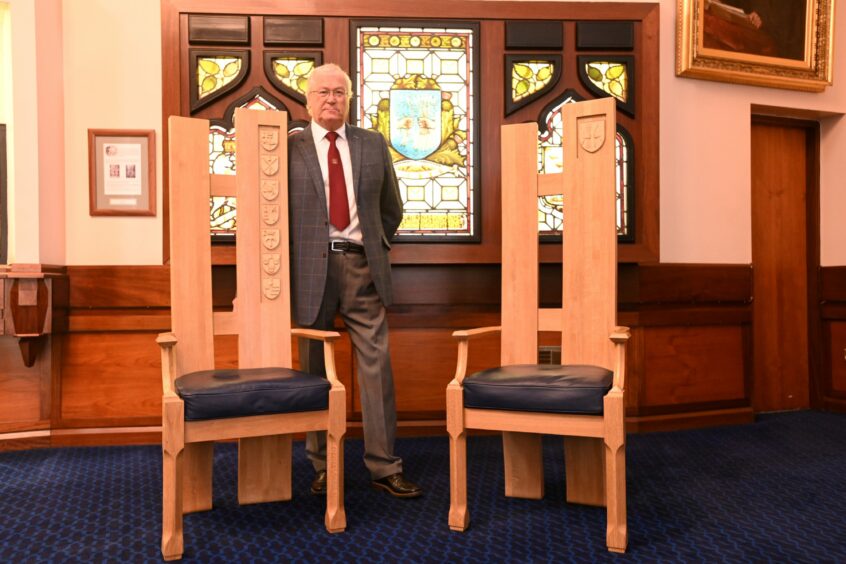
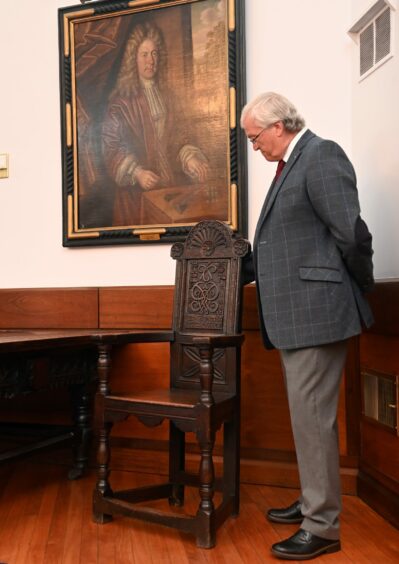

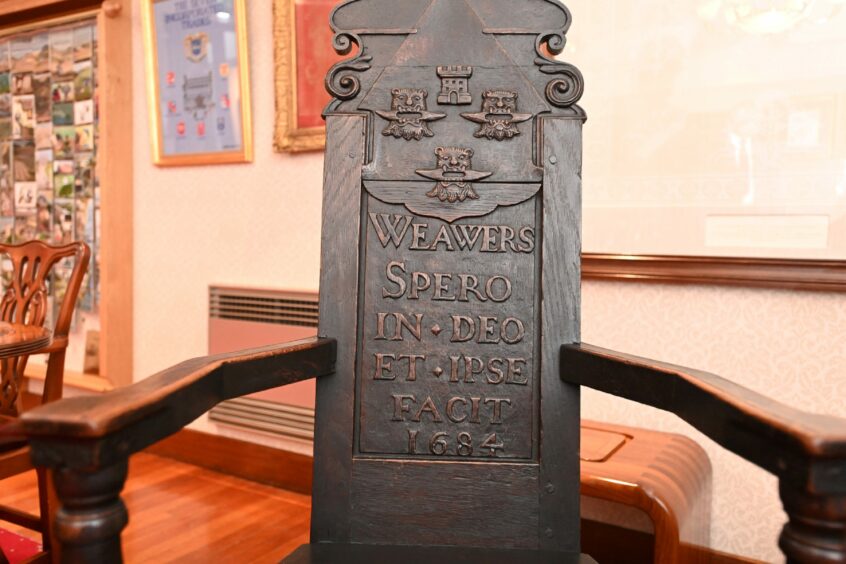

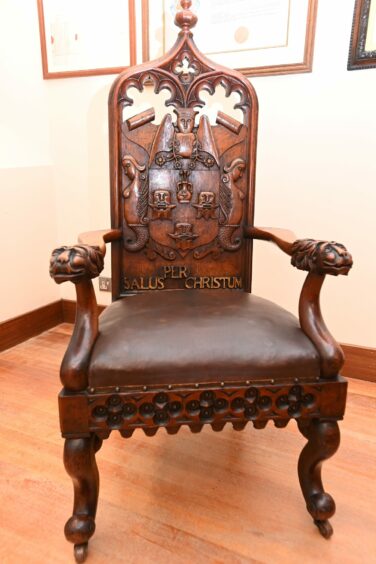










Conversation